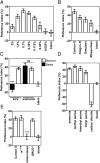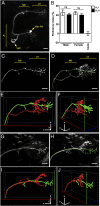Dedicated olfactory neurons mediating attraction behavior to ammonia and amines in Drosophila
- PMID: 23509267
- PMCID: PMC3619346
- DOI: 10.1073/pnas.1215680110
Dedicated olfactory neurons mediating attraction behavior to ammonia and amines in Drosophila
Abstract
Animals across various phyla exhibit odor-evoked innate attraction behavior that is developmentally programmed. The mechanism underlying such behavior remains unclear because the odorants that elicit robust attraction responses and the neuronal circuits that mediate this behavior have not been identified. Here, we describe a functionally segregated population of olfactory sensory neurons (OSNs) and projection neurons (PNs) in Drosophila melanogaster that are highly specific to ammonia and amines, which act as potent attractants. The OSNs express IR92a, a member of the chemosensory ionotropic receptor (IR) family and project to a pair of glomeruli in the antennal lobe, termed VM1. In vivo calcium-imaging experiments showed that the OSNs and PNs innervating VM1 were activated by ammonia and amines but not by nonamine odorants. Flies in which the IR92a(+) neurons or IR92a gene was inactivated had impaired amine-evoked physiological and behavioral responses. Tracing neuronal pathways to higher brain centers showed that VM1-PN axonal projections within the lateral horn are topographically segregated from those of V-PN and DC4-PN, which mediate innate avoidance behavior to carbon dioxide and acidity, respectively, suggesting that these sensory stimuli of opposing valence are represented in spatially distinct neuroanatomic loci within the lateral horn. These experiments identified the neurons and their cognate receptor for amine detection, and mapped amine attractive olfactory inputs to higher brain centers. This labeled-line mode of amine coding appears to be hardwired to attraction behavior.
Conflict of interest statement
The authors declare no conflict of interest.
Figures







References
-
- Vosshall LB, Wong AM, Axel R. An olfactory sensory map in the fly brain. Cell. 2000;102(2):147–159. - PubMed
-
- Clyne PJ, et al. A novel family of divergent seven-transmembrane proteins: Candidate odorant receptors in Drosophila. Neuron. 1999;22(2):327–338. - PubMed
-
- Vosshall LB, Stocker RF. Molecular architecture of smell and taste in Drosophila. Annu Rev Neurosci. 2007;30:505–533. - PubMed
Publication types
MeSH terms
Substances
Grants and funding
LinkOut - more resources
Full Text Sources
Other Literature Sources
Molecular Biology Databases

